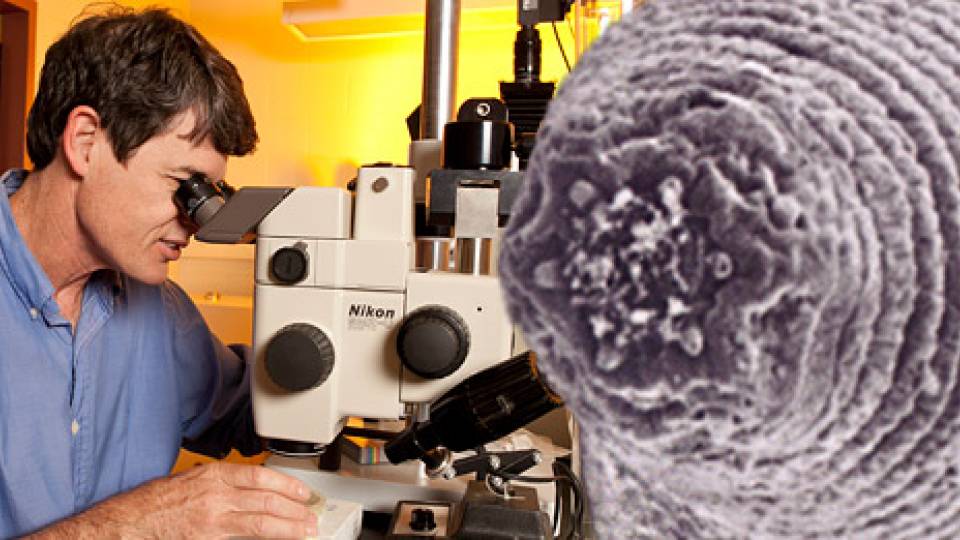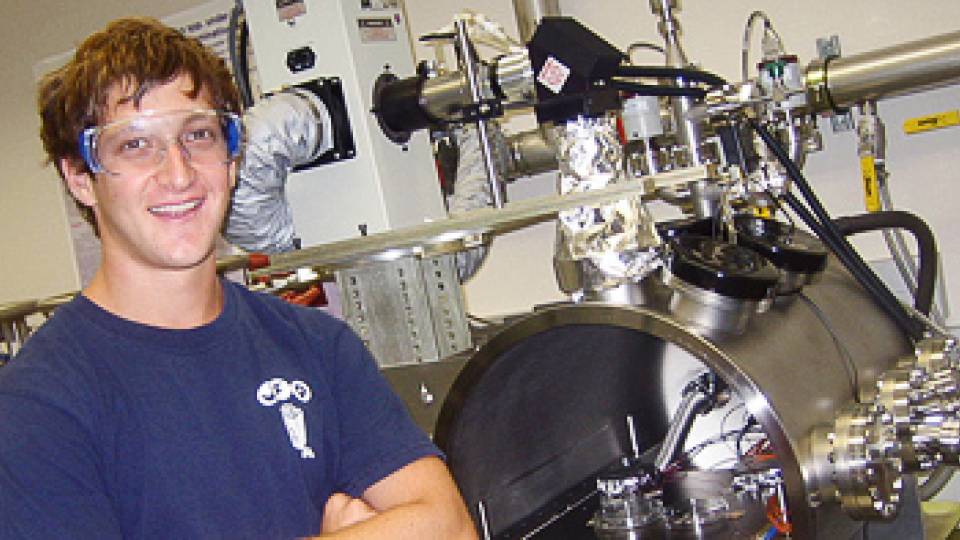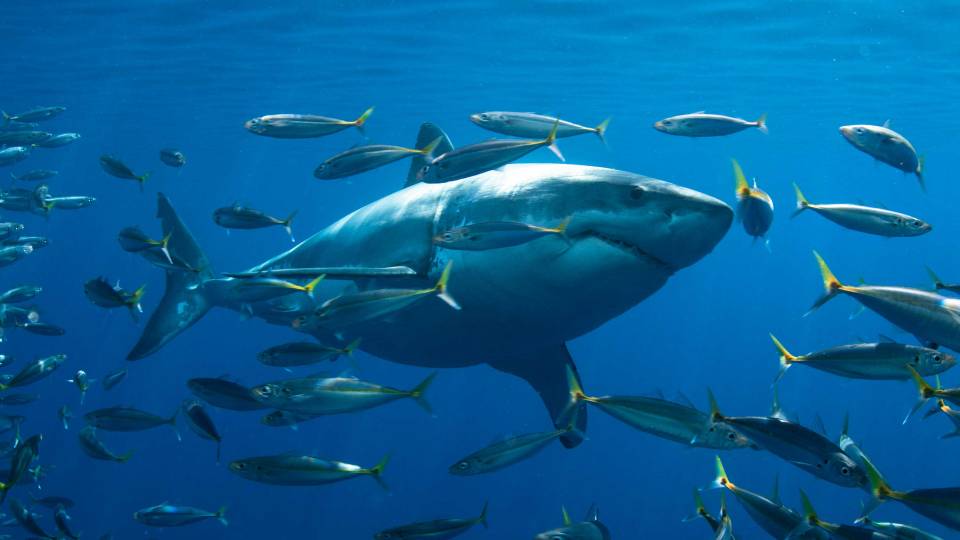A Princeton-led research group has discovered an isolated community of
bacteria nearly two miles underground that derives all of its energy
from the decay of radioactive rocks rather than from sunlight.
According to members of the team, the finding suggests life might exist
in similarly extreme conditions even on other worlds.
The self-sustaining bacterial community, which thrives in nutrient-rich
groundwater found near a South African gold mine, has been isolated
from the Earth's surface for several million years. It represents the
first group of microbes known to depend exclusively on geologically
produced hydrogen and sulfur compounds for nourishment. The extreme
conditions under which the bacteria live bear a resemblance to those of
early Earth, potentially offering insights into the nature of organisms
that lived long before our planet had an oxygen atmosphere.
The scientists, who hail from nine collaborating institutions, had to
burrow 2.8 kilometers beneath our world's surface to find these unusual
microbes, leading the scientists to their speculations that life could
exist in similar circumstances elsewhere in the solar system.
"What really gets my juices flowing is the possibility of life below
the surface of Mars," said Tullis Onstott, a Princeton University
professor of geosciences
and leader of the research team. "These bacteria have been cut off from
the surface of the Earth for many millions of years, but have thrived
in conditions most organisms would consider to be inhospitable to life.
Could these bacterial communities sustain themselves no matter what
happened on the surface? If so, it raises the possibility that
organisms could survive even on planets whose surfaces have long since
become lifeless."
Onstott's team published its results in the Oct. 20 issue of the
journal Science. The research group includes first author Li-Hung Lin,
who performed many of the analyses as a doctoral student at Princeton
and then as a postdoctoral researcher at the Carnegie Institution.
"These bacteria are truly unique, in the purest sense of the word,"
said Lin, now at National Taiwan University. "We know how isolated the
bacteria have been because analyses of the water that they live in
showed that it's very old and hasn't been diluted by surface water. In
addition, we found that the hydrocarbons in the environment did not
come from living organisms, as is usual, and that the source of the
hydrogen needed for their respiration comes from the decomposition of
water by radioactive decay of uranium, thorium and potassium."

Because the groundwater the team sampled to find the bacteria comes
from several different sources, it remains difficult to determine
specifically how long the bacteria have been isolated. The team
estimates the time frame to be somewhere between three and 25 million
years, implying that living things are even more adaptable than once
thought.
"We know surprisingly little about the origin, evolution and limits for
life on Earth," said biogeochemist Lisa Pratt, who led Indiana
University Bloomington's contribution to the project. "Scientists are
just beginning to study the diverse organisms living in the deepest
parts of the ocean, and the rocky crust on Earth is virtually
unexplored at depths more than half a kilometer below the surface. The
organisms we describe in this paper live in a completely different
world than the one we know at the surface."
That subterranean world, Onstott said, is a lightless pool of hot,
pressurized salt water that stinks of sulfur and noxious gases humans
would find unbreathable. But the newly discovered bacteria, which are
distantly related to the Firmicutes division of microbes that exist
near undersea hydrothermal vents, flourish there.
"The radiation allows for the production of lots of sulfur compounds
that these bacteria can use as a high-energy source of food," Onstott
said. "For them, it's like eating potato chips."
But the arrival of the research team brought one substance into the
underground world that, though vital to human survival, proved fatal to
the microbes -- air from the surface.
"These critters seems to have a real problem with being exposed to
oxygen," Onstott said. "We can't seem to keep them alive after we
sample them. But because this environment is so much like the early
Earth, it gives us a handle on what kind of creatures might have
existed before we had an oxygen atmosphere."
Onstott said that many hundreds of millions of years ago, some of the
first bacteria on the planet may have thrived in similar conditions,
and that the newly discovered microbes could shed light on research
into the origins of life on Earth.
"These bacteria are probably close to the base of the tree for the
bacterial domain of life," he said. "They might be genealogically quite
ancient. To find out, we will need to compare them to other organisms
such as Firmicutes and other such heat-loving creatures from deep sea
vents or hot springs."
The research team is building a small laboratory 3.8 kilometers beneath
the surface in the Witwatersrand region of South Africa to conduct
further study of the newly discovered ecosystem, said Onstott, who
hopes the findings will be of use when future space probes are sent to
seek life on other planets.
"A big question for me is, how do these creatures sustain themselves?"
Onstott said. "Has this one strain of bacteria evolved to possess all
the characteristics it needs to survive on its own, or are they working
with other species of bacteria? I'm sure they will have more surprises
for us, and they may show us one day how and where to look for microbes
elsewhere."
Other authors of this work include Johanna Lipmann-Pipke of
GeoForschungsZentrum, Potsdam, Germany; Erik Boice of Indiana
University; Barbara Sherwood Lollar of the University of Toronto; Eoin
L. Brodie, Terry C. Hazen, Gary L. Andersen and Todd Z. DeSantis of
Lawrence Berkeley National Laboratory, Berkeley, Calif.; Duane P. Moser
of the Desert Research Institute, Las Vegas; and Dave Kershaw of the
Mponeng Mine, Anglo Gold, Johannesburg, South Africa.
Pratt and Onstott have collaborated for years as part of the
Indiana-Princeton-Tennessee Astrobiology Institute (IPTAI), a
NASA-funded research center focused on designing instruments and probes
for life detection in rocks and deep groundwater on Earth during
planning for subsurface exploration of Mars. IPTAI's recommendations to
NASA will draw on findings discussed in the Science report.
This work was also supported by grants from the National Science
Foundation, the U.S. Department of Energy, the National Science Council
of Taiwan, the Natural Sciences and Engineering Research Council of
Canada, Deutsche Forschungsgemeinschaft (DFG, German Research
Foundation) and the Killam Fellowships Program.
More information about the discovery can be found at
http://newsinfo.iu.edu/news/page/normal/4229.html and
http://www.carnegieinstitution.org/news_releases/news_2006_1019.html
Abstract
Long-Term Sustainability of a High-Energy, Low-Diversity Crustal Biome
By Li-Hung Lin, Pei-Ling Wang, Douglas Rumble, Johanna Lippmann-Pipke,
Erik Boice, Lisa M. Pratt, Barbara Sherwood Lollar, Eoin L. Brodie,
Terry C. Hazen, Gary L. Andersen, Todd Z. DeSantis, Duane P. Moser,
Dave Kershaw, and T. C. Onstott
Geochemical, microbiological, and molecular analyses of alkaline saline
groundwater at 2.8 kilometers depth in Archaean metabasalt revealed a
microbial biome dominated by a single phylotype affiliated with
thermophilic sulfate reducers belonging to Firmicutes. These sulfate
reducers were sustained by geologically produced sulfate and hydrogen
at concentrations sufficient to maintain activities for millions of
years with no apparent reliance on photosynthetically derived
substrates.




